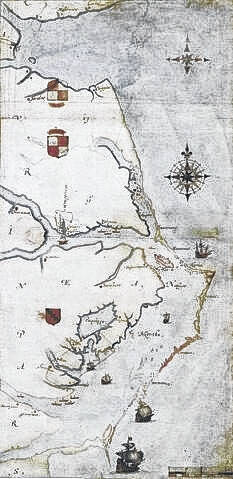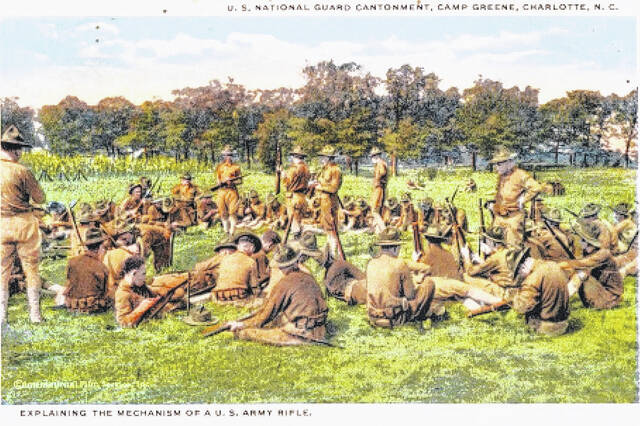
A map of the Roanoke Island from 1585 by John White
North Carolina Department of Natural and Cultural Resources
THIS WEEK IN HISTORY
ROBESON COUNTY HISTORY
April 7, 1924, The Robesonian reported the following: “McLean Endorsed For Governor By Home County Folks. Robeson County Precincts Enthusiastic for Home County Man—In Striking Contrast to Division in Bailey’s Home County. In striking contrast to the division in Mr. Bailey’s home county of Wake, reported elsewhere in this issue, was the hearty and unanimous endorsement of Mr. A. W. McLean for Governor in Democratic precinct meetings held Saturday throughout Mr. McLean’s home county of Robeson. Even Mr. Bailey’s home precinct defeated him, while in Mr. McLean’s home precinct there was not even the suggestion of opposition.”
April 3, 1974, The Robesonian reported on an initiative to expand medical training at UNC. “Rotary on Record for Med Training Expansion at UNC. The Lumberton Rotary Club went on record Tuesday as approving a report of the Board of Governors of the of the Universtiy of North Carolina, on expansion of medical training.
NORTH CAROLINA HISTORY
April 6: Camp Greene, Charlotte’s Massive WWI Installation. On April 6, 1917, the United States entered World War I. That summer, Major General Leonard Wood, charged with selecting sites for new military camps, visited Charlotte as part of a tour of prospective locations in North Carolina. Wood chose the Queen City as the site for Camp Greene, a 2,300-acre military training facility for the Army.
Named for Revolutionary War hero Nathanael Greene, the camp was constructed in 90 days, and by December it was a temporary home to nearly 60,000 soldiers.
The camp boosted Charlotte’s fledgling economy and the city’s population of 45,000 witnessed a major increase in jobs and wealth as restaurants, shops and other amusements directed at the soldiers were constructed. Unfortunately, the camp also spread communicable diseases. The winter of 1917 proved incredibly harsh and hundreds of soldiers and citizens succumbed to pneumonia. The following year, the influenza epidemic struck the camp and the city.
Many men who trained at Camp Greene ultimately were deployed to France and saw some of the heaviest fighting of the war. At the war’s end, the camp was dismantled, and it was closed officially in June 1919.
April 8: Baseball Legend “Catfish” Hunter. On April 8, 1946, famed baseball player James “Catfish” Hunter was born in Perquimans County.
Though Hunter excelled in a variety of sports in high school, his pitching skill was what stood out. Word spread fast, and soon major league scouts began to make the trip to Hertford to see him play. Though wounds from a hunting accident jeopardized Hunter’s prospects in the eyes of many professional scouts, the Kansas City Athletics had faith in the young pitcher and signed him to a contract.
Hunter was an immediate success with Kansas City, earning his first major league victory in July 1965 in Fenway Park in Boston. He pitched a perfect game against the Minnesota Twins after the Athletics moved to Oakland in 1968. After a contract dispute in 1974, he left the Athletics for the New York Yankees. He was the highest paid pitcher in baseball when he signed with the team in 1975. After retiring from baseball in 1979, Hunter returned to his native Herford, where he lived until his death in 1999.
Hunter’s numerous accolades include spots in the National Baseball and North Carolina Sports Halls of Fame, five World Series titles, and eight All-Star team appearances.
April 9: Lane Expedition Sails to America. On April 9, 1585, Sir Ralph Lane sailed with 107 colonists to America. A native of Devonshire, England, Lane entered into the service of Queen Elizabeth I in 1563. After serving as a courtier, soldier and sheriff, he was invited by Sir Walter Raleigh to command an expedition to America. By the end of June 1585 they had arrived at Wococon, what is now Ocracoke, on the Outer Banks. A colony was established there with Lane as the governor.
The colony later moved to Roanoke Island and established Fort Raleigh. In 1586, Lane and a group of colonists explored the Choanoac Indian country and the Chowan River. Thomas Harriot, a mathematician and scientist, and John White, an artist, were members of the expedition. Raleigh had sent Harriot to study the native inhabitants and explore the region’s plants, animals and minerals. White was hired to make maps and paint watercolors. Their findings were preserved in a book, A Briefe and true report of the new found land of Virginia.
By June of 1586, the colony’s supplies were running short. Sir Francis Drake arrived on June 11 and the discouraged Lane and other colonists abandoned the colony and boarded Drake’s ships to return to England.
NATION AND WORLD HISTORY
April 6, first modern Olympics begin. Today’s Highlight in History: On April 6, 1896, the first modern Olympic games formally opened in Athens, Greece
April 6, ABBA wins award. In 1974, Swedish pop group ABBA won the Eurovision Song Contest held in Brighton, England, with a performance of the song “Waterloo.”
April 7, civil war erupts in Rwanda. On April 7, 1994, civil war erupted in Rwanda, a day after a mysterious plane crash claimed the lives of the presidents of Rwanda and Burundi; in the months that followed, hundreds of thousands of minority Tutsi and Hutu moderates were slaughtered by Hutu extremists
April 7, Eisenhower’s domino theory: In 1954, President Dwight D. Eisenhower held a news conference in which he spoke of the importance of containing the spread of communism in Indochina, saying, “You have a row of dominoes set up, you knock over the first one, and what will happen to the last one is the certainty that it will go over very quickly.” (This became known as the “domino theory,” although Eisenhower did not use the term.)
April 8, Hank Aaron hits 715th homer, breaking Babe Ruth’s career record. On April 8, 1974, Hank Aaron of the Atlanta Braves hit his 715th career home run in a game against the Los Angeles Dodgers, breaking Babe Ruth’s record.
April 9, Lee surrenders to Grant. On April 9, 1865, Confederate Gen. Robert E. Lee surrendered his army to Union Lt. Gen. Ulysses S. Grant at Appomattox Court House in Virginia.
April 9, Funeral for Martin Luther King Jr. In 1968, funeral services, private and public, were held for Martin Luther King Jr. at the Ebenezer Baptist Church and Morehouse College in Atlanta, five days after the civil rights leader was assassinated in Memphis, Tennessee.
April 10, Titanic sets sail. On April 10, 1912, the British liner RMS Titanic set sail from Southampton, England, on its ill-fated maiden voyage.
April 11, Civil Rights Act becomes law. On April 11, 1968, President Lyndon B. Johnson signed into law the Civil Rights Act of 1968, which included the Fair Housing Act, a week after the assassination of Martin Luther King Jr.
April 12, Civil War begins. On April 12, 1861, the Civil War began as Confederate forces opened fire on Fort Sumter in South Carolina.
Executive Editor David Kennard compiles the History column from Robesonian archives, the North Carolina Department of Natural and Cultural Resources and Associated Press reports.










